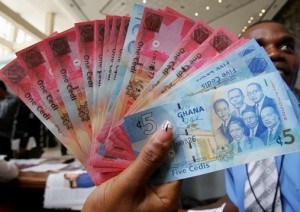Economist gives reasons for Ghana cedi depreciation
 Mr Habibu Adam, an Economist, has attributed the depreciation of the cedi to the structure of the economy, allowing foreign portfolio investments into the domestic bond market and the speculative attacks by either politicians or ‘rogue traders’ in the forex market.
Mr Habibu Adam, an Economist, has attributed the depreciation of the cedi to the structure of the economy, allowing foreign portfolio investments into the domestic bond market and the speculative attacks by either politicians or ‘rogue traders’ in the forex market.
Mr Adam said Ghana recorded trade deficit of $1.69 billion in 2016 as in many other years previously “this transformed to trade surpluses of about $1.19 billion and $1.78 billion in 2017 and 2018 respectively for the first time in decades. So why should the cedi be under pressure”.
The Senior Economist said this in interview with the Ghana News Agency in Accra.
Mr Adam said allowing the foreign portfolio investments (investments by non-resident Ghanaians) into our domestic bond market for which some of them are now moving their funds to their parent countries as it tapers, its rates higher as against the downward trend in the Ghanaian interest rates.
He said the other reason for the depreciation may be due to the huge interest servicing being made by government.
“Just before the IMF intervention in our economy, experts including then Vice-Presidential Candidate Dr Mahamudu Bawumia had warned of excessive borrowing which will cloud out fiscal space for government.
“Spokespersons of then government argued that as far as the debt level had not hit the unsustainable debt level of 70 per cent, they were not doing anything wrong.
“The end result was that, they left government leaving a debt level of 73 per cent of Gross Domestic Product (GDP) for the new government to grapple with,” Mr Adam said.
He said the resultant effect of the binge borrowing was that interest payments ten years (2008) ago was only GH¢679 million. This rose to GH¢10.7 billion in 2016 and is expected to hit GH¢18.6 billion by the end of 2019 (2019 Budget statement).
The Senior Economist said external debt constitutes 49.9 per cent of the public debt, therefore, “government will need to service the interest in foreign currency bringing additional burden on the cedi”.
Mr Adam said the final contributor to the depreciation of the cedi was the structure of the economy where “we export raw commodities and import almost everything in their value-added form.
“If the structure of the economy remains the same, no government will be able to halt the fall of the cedi. How can we be importing USD$2.0 billion worth of rice, USD$320 million worth of sugar and USD$ 374 million worth of poultry just to mention few and expect the cedi to be stable? All these commodities could be produced here”.
Mr Adam said in the last eight years before the current administration, the cedi had depreciated by 247 per cent giving an average annual depreciation of 30.9 per cent.
“The first two years of former President John Dramani Mahama’s administration recorded annual depreciation of 34.9 per cent.
“This compares to 6.43 per cent annual depreciation as at the end December, 2018 in the first two years of President Nana Addo Dankwa Akufo-Addo’s administration.
“Though a significant reduction; it is still not good enough. It is also important to acknowledge that the cedi has witnessed over 5 per cent depreciation in the first quarter of 2019 and it will be interesting to find out how it ends the year,” the Senior Economist said.
“In my opinion, the only way to end the cedi’s perennial depreciation is to embark on a comprehensive industrialisation policy together with improvements in infrastructure as well as modernisation of the agriculture and tourism,” he said.
Source: GNA
